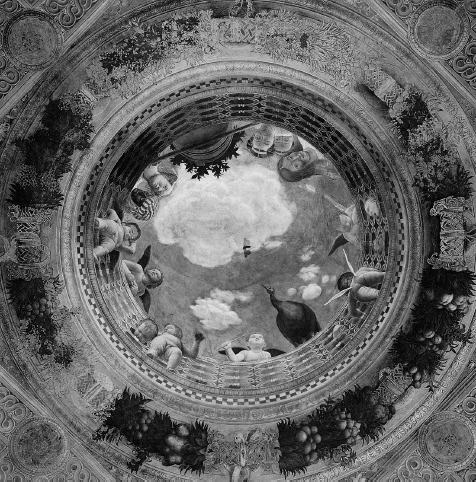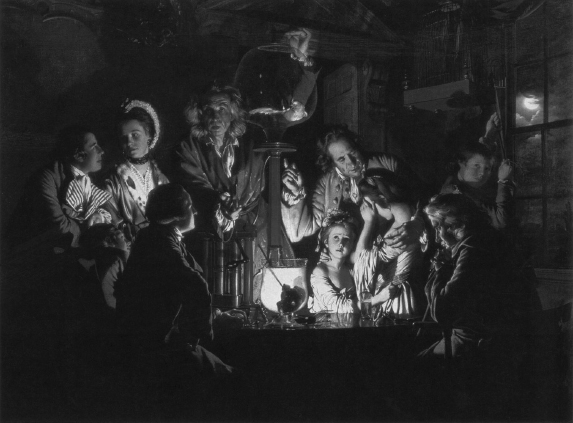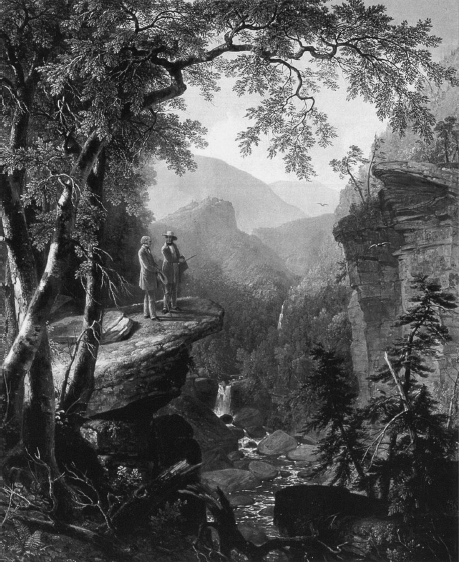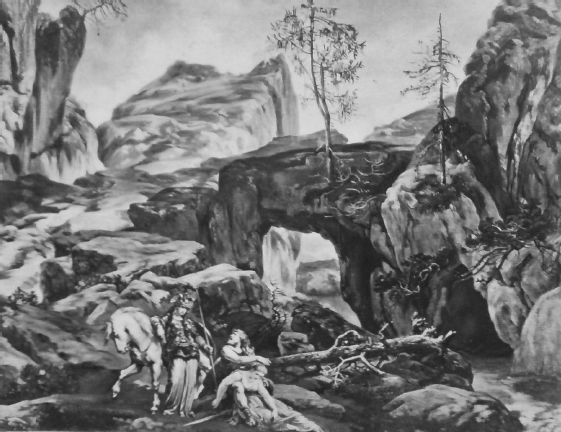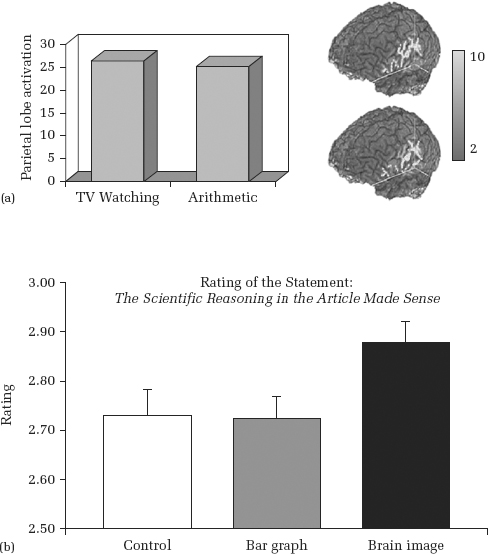Chapter 2
Science and Belief
A Nervous Romance
But the best demonstration by far is experience.
—Francis Bacon1
Sweet is the lore which Nature brings Our meddling intellect
Mis-shapes the beauteous forms of things We murder to dissect
—William Wordsworth
In Chapter One, we saw that we believe things (or not) partly due to the presence of peripheral cues—“peripheral” meaning that they are aspects of the situation that are irrelevant to whether or not the message is really true (for example, the attractiveness of the speaker or the length of the message). Although we are seldom aware that they influence us, these cues have an impact even when we consciously try to evaluate the logic and factual basis of a persuasive message. We also saw that we have a broad bias to believe new information if it is consistent with what we already believe, and we criticize new information that is inconsistent with our beliefs. To protect ourselves from believing false things, we need to (1) be aware of the peripheral cues that persuade, so that we can discount them, and (2) be aware of the beliefs we now hold, because they will bias how we evaluate new information.
Naturally, there is a lot of variation in what individuals believe, but in this chapter, I will suggest that there are also important commonalities of thought in the Western mind, expressed in two broad traditions. These traditions constitute meta-beliefs, as I called them in Chapter One—beliefs so general that they influence many other beliefs. They are really assumptions, ways of viewing the world, and they are so pervasive that we rarely think to question them.
The first meta-belief is that the best way to understand the world is through reason. It includes a confidence that our world—from the workings of the galaxy to the workings of our bodies—is subject to laws, and that the human mind can discover and describe these laws. According to this meta-belief, the epitome of reasoned thought is the scientific method.
The second meta-belief is that the best way to understand the world is through personal experience. According to this view, the scientific tradition overestimates what can be understood by reason, and people who overrely on it miss much of what is important, in particular the individual’s emotional responses. According to this view, a true understanding of what is important—especially in appreciating our natural world—means understanding that some things are mysterious and ineffable, and are not open to analysis by reason. Reasoning about them not only misses the point but destroys the experience altogether, as Wordsworth says in this chapter’s epigraph. By trying to analyze (that is, dissect) these sublime experiences, we destroy them.
The first meta-belief originated during the seventeenth century in conjunction with the development of the modern scientific method. This period is usually called the Enlightenment. The second meta-belief originated during the late eighteenth and early nineteenth centuries, a time usually called the Romantic period. Old though they may be, these meta-beliefs are still very much with us today. When an advertiser has an actor wear a doctor’s white lab coat for a cough syrup advertisement, or when a Web site selling educational software describes its impact as the correction of “brain glitches,” they are attempting to tap the residue of Enlightenment thinking. When a book promises to “unleash” hidden learning potential in your child, or when an advertisement for an ADHD treatment emphasizes that it is “drug-free and all-natural,” it is attempting to tap the residue of Romantic thinking.
In this chapter, I argue that each meta-belief is typified by certain catchphrases, and these catchphrases are peripheral cues to persuasion. They invite us to conclude that the new information offered to us—about cough syrup or about educational software—is consistent with one of these meta-beliefs, or even both. The catchphrases reassure us that the argument being made—“this cough syrup works”—is consistent with something we already believe, and thus the argument doesn’t need to be evaluated all that carefully.
I could simply list the catchphrases with the warning “Be on guard when you see these!” But to fully understand why they might work as peripheral cues (and to recognize others I have missed), you need to understand the meta-beliefs behind them. And to fully understand these meta-beliefs, we need a better understanding of their origins and justification. That takes us to sixteenth-century Europe.
The World Turned Upside Down
It is difficult to recognize our meta-beliefs and their influence exactly because we are immersed in them. Meta-beliefs are tantamount to a worldview, a lens through which all our experiences pass, so asking us to analyze them is like asking a fish to describe water. The best way to appreciate a worldview is to contrast it with another.
One of the most startling aspects of sixteenth-century European culture was people’s attitude toward evidence, what they found persuasive. Consider this. Suppose you wanted to persuade me that a husband and wife who don’t love one another can nevertheless have a happy marriage. What evidence would you guess I’d find convincing? You might tell me a story about a couple you know; she was a foreigner who wanted citizenship, and he was a businessman who wanted to be married for the sake of his career. They live together like roommates and both are happy enough with the arrangement. In short, you would try to convince me that you have seen the evidence with your own eyes.
In medieval thinking, seeing something with your own eyes was not the best evidence; it was the worst. Perception can deceive. Haven’t you noticed that a straight stick looks bent when it’s partly submerged in water? Haven’t you noticed that a man’s voice sounds different when he calls to you from a rapidly approaching horse compared to when the horse is running away? The senses are untrustworthy (Figure 2.1).
In contrast to our untrustworthy senses, we have available to us wisdom that has stood the test of time—most notably, the Christian scriptures. You want to know whether a marriage can be happy if the couple is not in love? The Bible has the answer: “Husbands, love your wives, just as Christ loved the church and gave himself up for her” (Ephesians 5:25). The ideal for marriage includes love.
Scripture was the most potent authority, but ancient Greek philosophers were also important, especially those whose thinking had been integrated into Christian thought. Foremost among these was Aristotle,a and an understanding of his system of physics was essential training in the late medieval period for those embarking on a career in theology, law, or medicine.2 Indeed, the thinking of Aristotle had such a profound influence that in 1585, Oxford University passed a decree that read
all Bachelaurs and Undergraduats in their Disputations should lay aside their various Authors, . . . and only follow Aristotle and those that defend him, and take their Questions from him, and that they exclude from the Schools all steril and inane Questions, disagreeing from the antient and true Philosophy . . .
b 3
In the fifteenth century, then, the world of ideas was static because one could not entertain ideas that conflicted with the authorities of the past.c This view profoundly affected how intellectual energy would be channeled. The goal of investigating nature was to understand the role that each object plays in God’s universe. The goal was not to change nature. That’s a core reason that we study nature today—to defeat disease, to increase crop yields. But to the medieval mind, God’s world was not to be tampered with, but rather to be understood, as a way of contemplating and appreciating God’s goodness and wisdom.
Needless to say, these are not the meta-beliefs shared by most Westerners today, nor by most educated Europeans by the end of the seventeenth century. The change was the consequence of an intellectual movement lasting roughly two hundred years from the early seventeenth century through the end of the eighteenth.d Although Enlightenment thinking touched on all aspects of human affairs—science, government, religion, the arts—I focus here on the change in how educated people thought about knowledge: How is knowledge acquired, and how certain is knowledge? To the medieval mind, authorities had provided things that one knew to be true, with certainty. Doubting them was irreligious. Today we hold ancient authorities in much less esteem; we assume that we have benefited from the experience of our forebears and actually know more than they. How did we come to change our beliefs about where knowledge comes from?
Let’s begin with the concept of doubt. Why did people in the seventeenth century decide that it was acceptable to doubt things, to ask questions? What shook them out of their fatalism, their unspoken assumption that nothing would ever change? The person most responsible was René Descartes. You’ve surely heard Descartes’ most famous quote: “I think, therefore I am.” What does that mean? Descartes was responding to philosophical skepticism, a strain of thought reaching back to the Greeks and popular again in the mid-seventeenth century, which asks, “How can we be certain that anything is true?” Well, to be certain that anything is true, you need to set some criterion of truth. In other words, you say, “If a statement meets these conditions, then I accept it as true.” For example, I might say, “If a statement agrees with something I observe with my own eyes, then I accept the statement is true.” But then I might ask, “But how do you know that your criterion of truth is reliable? How do you know that things you see with your own eyes are true?” So in response you provide some reason that this criterion of truth is reliable. For example, you might say, “Things I’ve seen with my own eyes have almost always proven true in the past.” But then I, in turn, might ask, “So that’s your reason for your criterion of truth; you’re saying that there is a history of things you’ve seen turning out to be true. But how do you know that that reason is reliable? How do you know that this history of reliability will continue?” In other words, every time you give me a criterion by which you know that some knowledge is true, I ask for a criterion for that criterion.
Many thinkers had, up to that point, simply scolded skeptics as irreligious. Descartes argued that the skeptic’s argument had to be taken seriously, and his statement “I think, therefore I am” was his answer. Descartes’ project was to find a criterion of truth that was reliable, a set of rules by which one could know something was true, with certainty. Descartes thought that if he could find a statement that could not be doubted, he could then discover why it could not be doubted, and then he’d have a criterion of truth—he’d know what characteristics a statement must have for one to be certain of its truth.
“I think, therefore I am” was the indubitable statement. Most any other statement could be doubted. You see something with your eyes, but how do you know it’s not a hallucination or a dream? You claim that 2 + 2 is 4, but you can’t really know that you haven’t made an error in calculation. But if I’m thinking, there must be some “me” to be doing the thinking. There’s no way around it.
Descartes made people take seriously the question “How do I know that something is true?” And in so doing, he invited doubt. He challenged his contemporaries to ask, “How do we know that this is true?” rather than simply accepting it as true because an authority said it.
In contrast to Descartes, who sought certain knowledge, John Locke argued persuasively that some knowledge is always bound to be imperfect. At best, we can say that something is very likely to be true, but never certain. Locke offered two broad reasons that this is so. First, he pointed out that human thinking is frail and subject to error. Our thinking is easily confused, our thoughts are often clouded through the misuse of language, and our memories are limited, so if a long chain of reasoning is necessary to connect two ideas, we’re likely to lose track.4
The second broad reason that we should consider knowledge at best probable is that it’s always possible that we’ll gain new knowledge tomorrow which shows that we are in error today. For example, suppose that you observe the Old Faithful geyser in Yellowstone National Park. For well over one hundred years, we have seen it shoot a plume of boiling water over a hundred feet high, with between fifty-five and ninety-five minutes elapsing between eruptions.5 So will Old Faithful erupt sometime tomorrow? That is certainly likely. But Locke would point out that there might be an earthquake tonight that disrupts the spring feeding the geyser. A diabolic team of anarchists might seek to plug Old Faithful. Improbable? Of course. But we can’t know that it won’t happen.6 Locke warns that we shouldn’t run with this idea and conclude that nothing is knowable, such that we are therefore paralyzed into inaction. (“Why go to work today? How do I know the world won’t end in thirty seconds?”) Locke says that the best possible knowledge arises when all people have the same experience and agree as to how to interpret it. That’s close to certainty, and we should act as though it were certain.
To people of the late eighteenth century, the idea that there was no certain knowledge was radical indeed. The Church certainly argued that there are many things that are known with certainty, and the Church further argued that it, as an institution, knew these Truths. Locke, in contrast, argued that what is known is known by experience, but even that knowledge is imperfect.
Important as Descartes and Locke were, perhaps the most important Enlightenment figure was Francis Bacon.7 Bacon argued forcefully for what we would today recognize as the scientific method as the royal road to knowledge: Bacon said that rather than taking authoritative sources as true, we must learn about nature by examining nature directly, as described in this chapter’s epigraph. By careful observation, we might then derive a generalization or law about the natural phenomena we observe. And Bacon added the crucial, final step: he said that we must test this law by generating new predictions from it, and seeing whether they are true.
So to summarize, Descartes encouraged people to doubt, and prompted them to ask themselves how they were sure they were right about what they thought they knew. Locke persuaded people that knowledge is never certain, but is always a matter of probability. And Bacon argued that the best source for knowledge is one’s own experience. The final figure I’ll mention provided an amazing example to the public of the success of the scientific way of thinking that these philosophers advocated. Isaac Newton showed that Bacon’s method was much more successful in revealing the order underlying God’s universe than was the study of scripture.
The most stunning example of this work was Newton’s Principia, published in 1687, which contained Newton’s laws of motion and law of universal gravitation. Johannes Kepler had, in 1609, published his three laws that described how the planets moved. Galileo had, in 1638, published the law relating distance, time, and acceleration of small bodies moving on Earth. Newton brought these observations and many others together into a coherent, mathematical description of our physical world. The implication seemed clear: our world is ruled by mechanistic laws, and humankind is capable of understanding and describing them.
Newton’s contribution was seen as dramatic verification of the value of the scientific method. The method was so successful that thinkers tried to apply it to realms other than the natural world. For example, philosopher David Hume’s great book A Treatise of Human Nature was subtitled Being an Attempt to Introduce the Experimental Method of Reasoning into Moral Subjects. Voltaire would later sum up Newton’s impact by arguing, in essence, “Newton was right, and so Enlightenment thought, although applied to other realms—political, moral, social—must be right too because we have used Newton’s method!”8
In the space of two hundred years—from 1600 to 1800—there was a truly remarkable transformation of what we have been calling meta-beliefs—the broad assumptions that one makes about the world. In 1600, Western Europeans viewed the world as static, and ordered by God in a way that was mysterious. Humankind could come to understand some of these mysteries, and in so doing better appreciate God’s creation. The way to arrive at this understanding was careful study of received authority. By 1800, Western Europeans viewed the world as dynamic and changeable, but subject to mathematical laws. Humankind could understand these laws, and the purpose of this understanding was not an appreciation of God’s majesty but to improve our well-being. The way to come to this knowledge was not to assume that received authority was correct but to observe the world, especially through scientific experimentation.
But how important was all this to the everyday life of average citizens? Isn’t this all just so much intellectual gas, so to speak? Initially, yes. But these ideas did filter down to a much broader reading public of lower nobility, doctors, lawyers, and merchants. In the eighteenth century, science became fashionable. England’s George III studied botany. Portugal’s John V studied astronomy.9 Lesser lights followed suit, perhaps not always making a substantial contribution to scientific advances (Figure 2.2), but certainly making a contribution to the change in mind-set of the populace (Figure 2.3). Indeed, many of what today are recognized as key texts in the transformation of mind fostered by the Enlightenment were not considered academic tomes at the time—they were best sellers. So the Enlightenment was not merely the province of an intellectual elite.
The Romantic Impulse
By the early decades of the nineteenth century, Enlightenment thought was so pervasive in the West that it could be considered conventional. Romanticism began in no small part in reaction to some Enlightenment views, particularly views of nature and of humankind.
In the Enlightenment view, nature was a mechanism, akin to an enormous, enormously complicated clockworks. Integral to Enlightenment thinking was the idea that nature was governed by laws and that the human mind, by harnessing reason through the method espoused by Bacon, could penetrate those laws. That’s what Newton had shown the world. Although the clockwork metaphor makes nature sound rather pedestrian, in fact Enlightenment thinkers conceived of nature as very close to the divine. Many argued that God did not want to make himself known only to those who had access to the Revelation; he would not deprive people in “backward” lands of knowledge of his goodness and his wisdom. Instead, God had made himself obvious to all through the glories of nature.e
Divine nature may have been, but Romantic thinkers were still disgusted by the mechanistic view of the universe. They saw nature as a poet sees it, not as a scientist does, and they thought that the proper response to nature was emotional, not rational. The raw power of nature—for example, the ability of a storm to wreak havoc—ought to fill one with trepidation. The majesty of a fog-wreathed mountain ought to fill one with awe. By trying to reduce nature to a system of mathematical equations, scientists were missing most of what mattered about nature, however close to the divine they might say it was. The Romantic view of nature is plain in paintings from the period (Figure 2.4).
Romantic thinkers were much less enthusiastic about the power of reason than their Enlightenment forebears. Although reason was clearly useful, they saw it as cold and in some way limited. They wanted to validate emotion as a response—or if not pure emotion, at least reason shot through with emotion.11 The ability to rouse emotion—especially deep emotions like terror—became a primary goal of Romantic art. Romantic poet William Wordsworth said, “Poetry is the spontaneous overflow of powerful feelings.”12 This interest in emotion as a viable human response could be found in other art forms—for example, music (Figure 2.5).
Wordsworth’s characterization of poetry as spontaneous is also important. Reason, after all, is time consuming, plodding. Intuition, in contrast, is rapid, spontaneous, unpredictable. In music, this idea was formalized in the nineteenth-century impromptu, a form meaning “offhand” or “spontaneous.” An impromptu was meant to sound as if the performer were creating the music as he played.
This idea of spontaneity fits too with another theme running through Romantic thought: that of hidden potential, hidden power. Romantic paintings often show a natural, peaceful scene, but one in which great forces have been at play; we see a mountain or a gorge, and we are left to imagine that great geological forces went into its creation. We see a blackened tree, and we are left to imagine the great storm during which it was shattered by lightning.
These four lines from Wordsworth’s “Tables Turned” capture many of Romanticism’s themes:
One impulse from a vernal wood
May teach more of man,
Of moral evil and of good,
Than all the sages can.
Sages who reason are rejected. Matters of importance may be understood by close attention to our personal, spontaneous responses to nature.
Meta-Beliefs in Education Today
Let’s take a step back to recall the big picture. Each of us inevitably holds beliefs about the nature of the world and of humankind, and about how people come to know things. I have described two prominent and highly influential sets of such beliefs, one from the Enlightenment and the other from the Romantic era. Naturally, I’m not claiming that these beliefs exclusively dominate the thoughts of everyone today. There are other important meta-beliefs that have their origins elsewhere, most notably religious faith. But when we look about us today, we seldom see people trying to use nineteenth-century American populism or the Great Awakening as intellectual touchstones for educational methods. They frequently, however, base arguments about learning on meta-beliefs from the Enlightenment and Romantic eras. So what do these arguments look like?
The arguments are often indirect, or even telegraphic. The person doing the persuading doesn’t want you to think carefully about whether or not the new educational program is a good idea; it’s much better from his perspective if he gets you to think that you already believe it, because, as described in Chapter One, we are all biased to maintain our beliefs. So rather than provide an elaborate justification, he’ll toss out a few pat phrases that draw on Enlightenment or Romantic meta-beliefs. He’s gambling that these ideas resonate with the audience. Even though the information provided might be irrelevant, it feels right to us because it travels well-worn patterns of thought. We’ve reasoned using similar lines before (“Science proves the truth”), so thinking about this new claim (“It’s true because it’s scientific”) seems fluent and easy and, therefore, probably correct.13 The “No Child Left Behind” act of 2002 refers to “scientifically based” research more than one hundred times.f
Enlightenment meta-beliefs dictate that reason is the best way to understand the world and that the scientific method is the best way to deploy reason. Thus people draw on these ideas by claiming that the educational program they advocate is research based. The imagery and authority of science are often invoked. Technical jargon is used to explain why the program will be effective. We are asked to believe authority figures who tell us that it will work, but the authority figures are not from the clergy. They are scientists in white lab coats. Figure 2.6 shows figures similar to those culled from the front page of a Web site that offers homeopathic remedies for ADHD. Homeopathy is a pseudoscientific alternative medical approach that is not supported by the majority of clinical studies.g
Another potent symbol of “science” in education is anything related to the brain. Cynics have labeled this tendency neurophilia (from the Greek roots neur, meaning “nerve,” and phil, meaning “love”). Research indicates that people do indeed love the brain. For example, in one study, subjects read descriptions of well-established psychological phenomena.14 After subjects read a description, they saw one of two explanations of why it happens. One explanation made sense, but the other didn’t. In addition, the explanation either included neuroscientific information or didn’t—but when present, the neuroscientific information was always irrelevant to the explanation.
Subjects rated explanations as more satisfying when they included the irrelevant neuroscientific evidence. Without the neuro-verbiage, subjects accurately saw that a bad explanation didn’t make sense, and rated it as poor. But the neuro-nonsense obscured that, and subjects rated the bad explanation as okay (although not as good as the good explanation).
Even pictures of the brain make information seem more scientific. For example, in one study, researchers had people read a description of a study titled “Watching TV Is Related to Math Ability.” The study reported the (fictitious) finding that the same part of the brain is active when people watch TV and when they solve math problems. It concluded that watching TV helps you learn math. Even if the finding were true, the conclusion does not logically follow. Maybe the part of the brain that’s active during math and during TV watching is the part of the brain that supports paying attention; you pay attention when you do either task. But the conclusion seemed more logical to people when they saw a picture of the brain, as shown in Figure 2.7.15
It’s no surprise, then, that people trying to sell education products try to capitalize on neurophilia by labeling them “brain based” and using images of the brain. I’ll have more to say about how neuroscience relates to education in Chapter Four.
What about Romantic meta-beliefs? These meta-beliefs find expression in a few ways. The first is an emphasis on the natural. Recall that Romantics held an almost religious reverence for nature, and this reverence is seen in American culture today in our regard for natural products. We believe that spring water must be not only clean but also superior to tap water because it comes directly from the Earth and is not processed.16 People believe that herbal remedies are less likely to lead to adverse reactions than manufactured pharmaceuticals17 and are generally less risky to take.18 Of course, the fact that something is found in nature doesn’t mean it’s healthful. Nightshade is perfectly natural, but you’ll die if you eat its lovely purple berries.
The meta-belief “natural is good” runs deep in education. For kids who suffer from ADHD or another disorder for which medicines are available, there is a panoply of “natural” treatments: alternative diets, exercises, homeopathy, and others, all of which trumpet their “natural” credentials. Another, more subtle manifestation of Romanticism’s reverence for nature is the view that learning is natural, meaning that it is the normal state of affairs for children to be curious and to learn. Think of the natural curiosity of a toddler and compare that to the curiosity of a teen. Doesn’t it seem obvious that school deadens a child’s natural curiosity? This Romantic meta-belief is tapped by using peripheral cues like the phrases “learn the natural way,” and “draws on the child’s natural curiosity.”
Less often, the negative side of schooling is described: arguing for the unnaturalness of asking children to sit at desks in rows, or likening school to a factory (with students as output) or to a prison with the same deadening routine and lack of freedom. Learning is natural and will occur healthily and bountifully if nature is allowed to take its course. Schooling, as an adult construction, is an encumbrance to this process; school is the problem, not the solution. The nub of the argument is that students should have a good deal of say in what they want to learn. Such arguments have long been the basis for one variety of nontraditional schools. The basic ideas date to eighteenth-century philosophical works, including Rousseau’s Emile (1762) and Pestalozzi’s Leonard and Gertrude (1781), but they pop up repeatedly, often with an Enlightenment twist. The idea that children are innately wise and that learning is the mere unfolding of innate abilities is offered as a scientific insight based on recent research, as in the 1960s’ Summerhill and again in the 1980s’ Teach Your Own.19
This Romantic meta-belief is partly true, but easily twisted out of shape. There are some things that humans are primed to learn, especially how to walk, how to talk, and how to interact socially. Each represents a highly complex skill that most children learn without the benefit of instruction, simply by watching others; thus such learning can fairly be called natural and effortless. But most of what we want kids to learn in school is qualitatively different. Kids do not naturally learn to read simply through the opportunity to observe others reading, although this idea has been suggested more than once in the history of education.
So one Romantic notion is that the child has a natural propensity to learn, but that this impulse is crushed by the unnatural, deadening school routine. This idea—of a bad fit between the child’s natural propensities and the procedures at school—lends itself to still another Romantic idea. Recall that Romantic thinkers were fascinated by hidden powers, hidden potential in an individual or in nature. In education, this idea is expressed as the possibility of “unleashing” or “unlocking” learning. The child’s intellectual ability is, we are told, much greater than what we are seeing. The right instructional methods will unleash this hidden potential, and we’ll see great things from the child.
From a cognitive point of view, this idea is almost certainly wrong. Nothing in the mind is locked or leashed. Sure, we learn much faster and with greater pleasure and enthusiasm when the learning experience is pleasant or when things are put to us clearly and in context, rather than some dry recitation. But the idea that powerful forces lie dormant within us and that these forces can be harnessed? That’s a fantasy, a pleasant dream. Everyone can improve at any skill he or she works at. But it does take work, not the simple turning of a key in a lock.
Another aspect of Romanticism expressed in educational programs is the emphasis on the individual. If individuality is paramount in your mind, you could easily conclude that a teacher, however skilled, could never honor the interests and abilities of thirty different students. The terms “one size fits all” or “cookie cutter” are often used pejoratively in this context. Marketing a product as one that honors the individual resonates with a parent who feels that his or her child is a square peg trying to fit in the round hole of schooling. Products may boast that they are “tailored to the individual” or that they “respect your child’s learning style.”
There is a valid point here, and it does contrast sharply with the Enlightenment view and with the scientific view in general. Let me make this point by stating two extreme positions, neither of which many people would embrace.
Enlightenment position: there are no important differences among kids, so the goal ought to be to find the best way to teach reading (for example) and then use that with all kids.
Romantic position: every child is unique, so it is hopeless to try to define educational “best practices.”
The truth is bound to be somewhere in the middle. Most kids are similar enough to one another that it’s a realistic scientific goal to talk about “how kids learn” just as we can talk about “how kids digest food” and “how kids breathe.” It doesn’t mean that our conclusions will apply to every child—some have a digestive disorder, for example—but it ought to apply to a lot of kids. That said, there’s no doubt that schooling is more complicated than digestion. The raw memory processes may be pretty similar across kids, but there are surely differences in kids’ motivation for school and the particulars of what motivates them, just as one example. I’ll have more to say about the role of science in education—what it can and can’t contribute—in Chapter Four. For now, let me just note that extreme positions—that schools can safely ignore any and all differences among kids or that schools must provide qualitatively different instruction for every child—are not in keeping with what’s known about the mind.
Although I introduced Romantic thought as a reaction to the Enlightenment, today the two live together in peace, at least in popular culture. For example, one Pantene shampoo advertisement (Figure 2.8) offers imagery from both Romantic and Enlightenment views. And the voice-over suggests that the shampoo can “unlock the potential of nature” through the use of “Pantene Pro V science.”
What’s true of beauty products is true of educational programs. Many programs have a Romantic sensibility, but claim to offer Enlightenment-style scientific proof. For example, the Web sites that promise to unleash your child’s hidden potential often claim that their methods are brain based and scientifically proven. The purveyor of “natural” dyslexia treatments emphasizes that they’re backed by scientific proof.
• • •
In this chapter, I’ve described some peripheral cues frequently used to boost the credibility of educational programs; I’ve summarized them in Table 2.1. As evidence, most are neutral. In other words, the mere presence of these cues doesn’t mean that an educational program or curriculum is bad, or poorly supported. Not everything that trumpets “All Natural!” is a waste of money. All I’m claiming is that the presence of these cues should do nothing to persuade you that it’s a good idea. The exception, I’m claiming, is any that promises to unlock or unleash cognitive ability. That promise will go unfulfilled. For the others, we need only to disregard the peripheral cues to ensure that we don’t get sucked into thinking that the program resonates with deeper beliefs that we hold, whether Romantic or Enlightenment.
TABLE 2.1: Pat phrases that tap Enlightenment or Romantic themes.
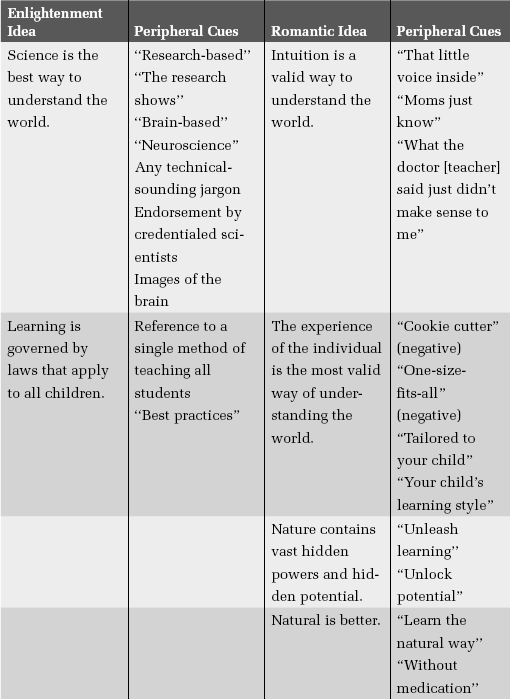
Okay, so we know what to disregard. But what do we look for? How can you recognize an educational program that really does have scientific backing? In the next chapter, we’ll discuss what real science looks like.
Notes
1. Bacon, F. (2000). The new organon (Book 1, Aphorism 70; L. Jardine & M. Silverthorne, Eds.). Cambridge: Cambridge University Press. (Original work published 1620)
2. Stone, M.W.F. (2002). Aristotelianism and Scholasticism in early modern philosophy. In S. Nadler (Ed.), A companion to early modern philosophy (pp. 7–24). Malden, MA: Blackwell.
3. Wood, A. (1796). The history and antiquities of the University of Oxford (Book 1; J. Gutch, Trans.). Oxford: Oxford University Press, p. 226. Available online at http://books.google.com/books?id=0gYVAAAAQAAJ&pg=PA226&lpg=PA226&dq#v=onepage&q&f=false.
4. Locke, J. (1899). An essay concerning human understanding (Book 4, chap. 17). Available online at http://etext.lib.virginia.edu/etcbin/toccer-new2?id=LocHuma.xml&images=images/modeng&data=/texts/english/modeng/parsed&tag=public&part=72&division=div2. (Original work published 1690)
5. Yellowstone Net. Geysers of Yellowstone—Old Faithful. http://www.yellowstone.net/geysers/geyser11.htm.
6. Locke, J. (1899). An essay concerning human understanding (Book 4, chap. 16). Available online at http://etext.lib.virginia.edu/etcbin/toccer-new2?id=LocHuma.xml&images=images/modeng&data=/texts/english/modeng/parsed&tag=public&part=71&division=div2. (Original work published 1690)
7. Many others have been called “the father of modern science,” including Thales of Miletus (c. 624 BC–c. 546 BC), Democritus (c. 460 BC–c. 370 BC), ibn al-Haytham (965–1040), Roger Bacon (1214–1294), Leonardo da Vinci (1452–1519), and Galileo (1564–1642).
8. Gay, P. (1969). The Enlightenment: An interpretation. From science to freedom. New York: Norton, p. 137.
9. Gay, P. (1966). Age of enlightenment. New York: Time-Life.
10. Credited as Astronomy, a hand-colored engraving after a mezzotint by Richard Houston, c. 1750, Museum of the History of Science, Oxford.
11. Fairchild, H. N. (1931). The Romantic quest. New York: Columbia University Press.
12. Wordsworth, W. (1802). Lyrical ballads. London: Longman, pp. x–xi.
13. Trout, J. D. (2008). Seduction without cause: Uncovering explanatory neurophilia. Trends in Cognitive Science, 12, 281–282.
14. Weisberg, D. S., Keil, F. C., Goodstein, J., Rawson, E., & Gray, J. R. (2008). The seductive allure of neuroscientific explanations. Journal of Cognitive Neuroscience, 20, 470–477.
15. McCabe, D. P., & Castel, A. D. (2008). Seeing is believing: The effect of brain image on judgments of scientific reasoning. Cognition, 107, 343–352.
16. Ward, L. A., Cain, O. L, Mullally, R. A., Holliday, K. S., Wernahm, A.G.H., Baillie, P. D., et al. (2009). Health beliefs about bottled water: A qualitative study. BMC Public Health, 9, 196.
17. Newall, C. A., Anderson L. A., & Phillipson, J. D. (1996). Herbal medicines. A guide for health-care professionals. London: Pharmaceutical Press.
18. Klepser, T. B., Doucette, W. R., Horton, M. R., Buys, L. M., Ernst, M. E., Ford, J. K., et al. (2000). Assessment of patients’ perceptions and beliefs regarding herbal therapies. Pharmacotherapy, 20, 83–87.
19. Neill, A. S. (1960) Summerhill: A radical approach to child rearing. New York: Hart; Holt, J. (1981). Teach your own: A hopeful path for education. New York: Random House.
